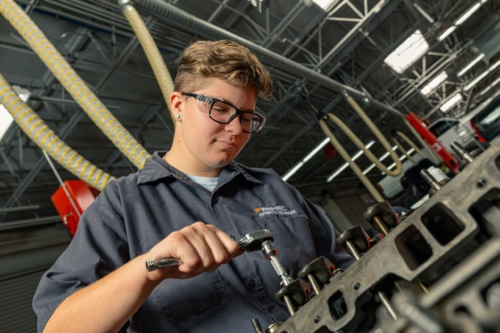Over the last three decades, girls’ academic and postsecondary outcomes have exceeded those of boys. Parents and educators are seeking solutions to foster students’ college attainment and career success. Committed to equity, the educational system must acknowledge that boys are falling behind and work to reverse this trend.
Educators and Virtual VISION presenters Speranta Klees and Aaron Parsons recommend a solution to help remedy the alarming decline in the academic performance of boys and propel them into successful postsecondary attainment: career and technical education (CTE). CTE provides all secondary students a powerful set of advantages to ignite college success:
- Relevance
- Early college opportunities
- Greater self-efficacy — a belief in one’s ability to solve problems
The staff at Western Maricopa Education Center (West-MEC), the largest CTE district in the greater Phoenix, Arizona, area, examined scholarship from the Pathways to Prosperity Project at Harvard University’s Graduate School of Education. And we found a common reason students drop out of high school and college:
“…too many can’t see clear, transparent connection between their program of study and tangible opportunities in the labor market.”
West-MEC staff intentionally make those connections evident to students to ensure program completion and industry certification. With program completion and industry certification rates in the high 90% range, West-MEC’s next big step was to align its programs with postsecondary pathways.
Postsecondary alignment
West-MEC students can earn up to 52 college credits in aviation technology or 30 college credits in IT security, to highlight only two programs.
“Dual enrollment helps me with my college career by giving me a great direction for my future studies,” said Calista Orr, a student in automotive technology.

West-MEC data shows increased participation in early college programs by all students. We are also now seeing more senior boys completing high school, achieving in-demand industry certifications and even earning associate degrees.
Garrett Williams, an aviation program completer, is proud of his effort: “West-MEC was a good experience to get me to the final outcome, which was to work at an airline. It was a lot of work, but the benefit to graduate with my diploma, an associate degree, and my air frame >amp; powerplant certification was worth the effort!”
Self-efficacy leads to achievement.
Recent studies link grit, self-efficacy and student achievement, validating West-MEC’s core belief that success leads to success. As students, including boys, reach higher GPAs, grow a bank of college credits, and experience academic success and career pathway activities, their sense of efficacy increases. With increased self-efficacy, students become grittier and develop a renewed confidence in their ability to complete college. Our CTE pathways create option-rich links between high school, college and career.

How does West-MEC help boys with specific strategies for success?
We know that reading and writing are strong predictors of success. We also know these are the areas in which boys fall the farthest behind girls. By eighth grade in the U.S., 41% of girls are, at minimum, proficient in these skills and only 20% of boys are. Behind in reading, many boys can’t work though word problems and long sentences to get to the math calculations they are typically able to solve. Thus, poor reading skills lower boys’ math assessment scores as well.
The technical reading material that is inherent to CTE (e.g., charts, diagrams or how-to manuals) may effectively challenge male students to increase their comprehension and vocabulary skills. At West-MEC, we use technical manuals to extend skills further through the application of speaking, writing, reading and listening (SWRL) strategies. With technical reading as the foundation, we see boys and girls achieve parity in reading assessments; moreover, we also see gains in the math assessments of both sexes.
The typical classroom norm — sitting, talking and listening — is hard for many boys. Movement is the preferred learning style for boys, and its use decreases progressively as boys matriculate through high school. When CTE classes integrate movement, learners are better able to understand the material. They become more motivated to achieve higher and succeed. At West-MEC, we determined our coding program did not offer enough movement, so we added five minutes of moderate to vigorous physical activity each day. Due to the COVID pandemic, this intervention is, of course, on hold.
Actionable Strategies
Take notice: Boys are largely absent from scholarship, awards or college admissions.
All students, especially boys, are much more likely to complete a rigorous postsecondary pathway if it clearly links current with future learning and aligns career goals.
West-MEC maintains that success leads to success. All students can succeed.” With the adoption of deliberate alignment and guidance toward dual and concurrent enrollment, and a hands-on, movement-oriented environment, boys develop an increased sense of efficacy toward postsecondary pathways. All students deserve postsecondary attainment within their grasp.
Tune in to ACTE’s CareerTech Virtual VISION, Nov. 30–Dec. 4, for more from Speranta Klees and Aaron Parsons. Don’t miss their session — Left Behind: Boys Need CTE.
Speranta Klees is the postsecondary partnerships manager for West-MEC.
Aaron Parsons, Ed.D., is an assistant campus administrator at West-MEC.






